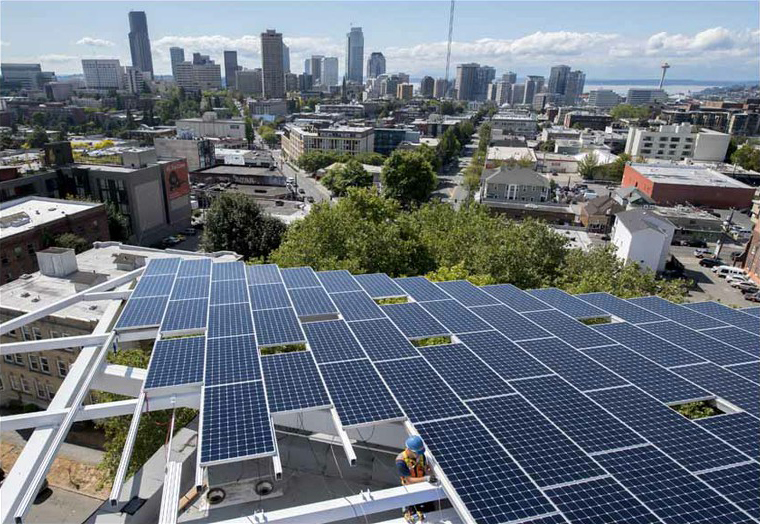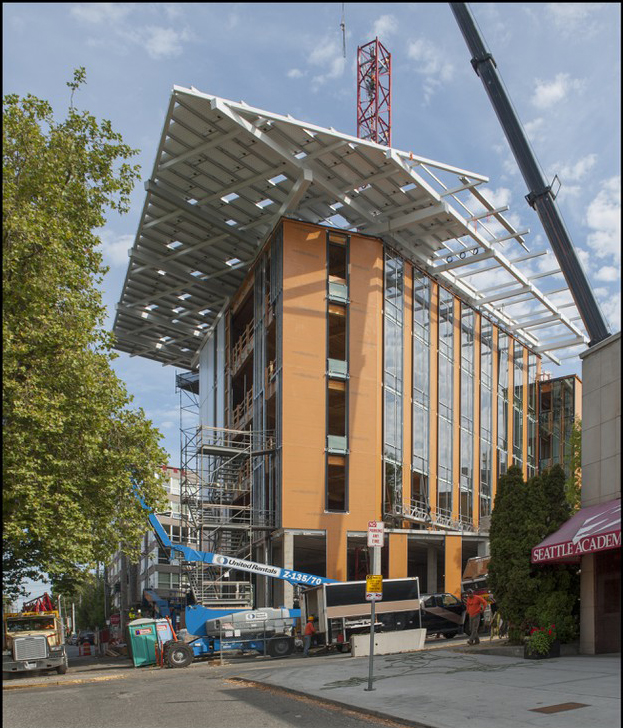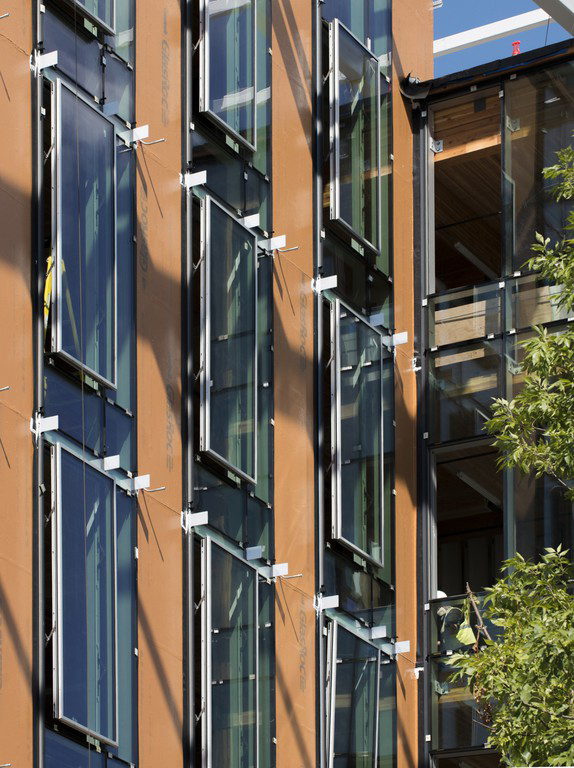'The World’s Greenest Commercial Building"
Air Date: Week of April 19, 2013

The Bullitt Center solar roof under construction. (Photo: John Stamets)
Seattle public radio station KUOW reporter Ross Reynolds visits the deep green Bullitt Center along with the man who dreamed it up, Denis Hayes. As Hayes explains, the Center is a self sufficient building designed to emulate a living organism.
Transcript
CURWOOD: Earth Day, April 22, was set as the official opening day of what Mr. Earth day, Denis Hayes, calls the greenest building in the world. It’s a six-story office structure built to house the Bullitt Foundation, which Mr. Hayes heads, and other tenants they hope to attract. As workers were putting the finishing touches on the building, Ross Reynolds of member station KUOW in Seattle got Denis Hayes to take him on a tour.
HAYES: This is a building that functions like an organism - so say it has ears, it has eyes, it doesn't have a sense of smell, but it has pores that open and close automatically depending upon outside conditions. It has a sophisticated nervous system, and it has a brain. It has an alimentary canal, that's the only six-story building in the world with composting toilets. And it functions very much like the Douglas Fir forest functioned when it was here 150 years ago.
REYNOLDS: Let's go inside this building that can see and hear and is like a living being.
HAYES: And I should say that the water on the park...we're not bringing in irrigation water, this will be watered naturally. The water that falls on the building – instead of running off and down a gutter into the street and carrying hydrocarbons into a storm sewer into Puget Sound – the water will be used for all purposes inside the building. The grey water will then be filtered and infiltrated into the rain garden down in front. And again, just like that Douglas Fir forest, the water that falls on the site remains on the site.

The Bullitt Center. (Photo: John Stamets)
So we've done everything we can with the core and the shell of the building, with the tenant improvements we've put in; we've got the most efficient appliances that we can in the kitchens, but in the end, what's left is plug loads - what you as a tenant bring in and plug in as a computer, as a lighting system. And we've limited the budgets; when you come in your lease contains provisions that say this is how much energy you can use per square foot that you've leased. We've got these little kilowatt meters that you measure everything that you're currently using, and it tells you how much of a draw your computers are and your task lights are and your printer is and what have you. And you just calculate a way to stay within that budget.
REYNOLDS: Now a water budget, too, so if I'm overflushing you might be knocking on my door and telling me about it?
HAYES: Well, you'd have to overflush a whole lot, because we have composting toilets that use trivial amounts of water. A flush is about one cup.
REYNOLDS: Denis Hayes is taking some time in his very busy week as they prepare to move into their new building in Seattle to give us a tour and tell us about some of the features.
HAYES: So this will be our big education center, this partnership for urban ecology between the University of Washington and the US Green Building Council and us will operate.
REYNOLDS: And this is a lovely space. It's got floor to ceiling windows. And the ceilings here are really high, full of light, facing south. Great exposure.

The highly efficient windows of the Bullitt Center open automatically when it's hot. (Photo: John Stamets)
HAYES: And by very high we're talking in excess of 20 feet. We'll have all kinds of displays in here and things that will attract the public and we'll bring in school kids. But the real emphasis of this partnership is targeted. If you want to change radically the way things are built, there are a number of decision makers that you need to get engaged. They certainly include architects, but they tend to be wildly enthusiastic about this sort of thing anyway. Developers, a little bit less so. Bankers, deeply skeptical. Appraisers, completely bewildered.
So we're going to be having a series of programs to try to educate all of those about why it is desirable to have features from this building become commonplace. Local politicians and community leaders...I mean two dozen things in this building would have been illegal under Seattle's prescriptive codes. But as long as we can show that this building, by being truly innovative in its integrated design, would have much better performance than the code would have produced, they would give us an exemption and say OK, we'll use your performance standards instead. And we'd love to get that replicated in thousands of cities across the country.

The Bullitt Center under construction. (Photo: John Stamets)
REYNOLDS: I've got to say, I'm impressed with what you're showing me, Denis. But I'm wondering - the cutting edge can be the bleeding edge. Is this Bullitt Foundation building bulletproof or is there technology in here that is a little experimental, that you're not 100 percent sure that is going to work?
HAYES: Ah, no. There's nothing in here that we're not 100 per cent sure that is going to work. That's to say every building gets commissioned. And we've got lots of moving parts – windows that open automatically and close automatically. Shutters that come down automatically, go up automatically. There are things that are going to malfunction in the first month. We've got a first-rate team of building managers who will get them fixed. It will be shaking down but none of these are going to be permanent failures. Everything here exists someplace else. It's just not been put together in one package.
REYNOLDS: And you mention the building sees. That's one way it sees – it sees that it's time to close the shades?
HAYES: Yes. The software on this is relatively sophisticated. The building has a brain. It has a nervous system. So across the street we've got a nerve ending that's a weather station that tells you what's the temperature outside. Is the wind blowing? How fast is it blowing? What direction is it blowing from? Is it raining? And it feeds all of that information along with the internal stuff from the building...how warm is it inside? What is the carbon dioxide level? All that stuff goes down to the building's brain and it decides whether the windows should be open or closed.
REYNOLDS: Well, what else would you like to show us next?
HAYES: To make the tour efficient, why don't we show where the toilets go to? And then we'll show you the toilet itself. Right now we're installing the connections between the toilets on the sixth floor and the compost bins in the basement.
[FOOTSTEPS WALKING DOWN STAIRS]
REYNOLDS: So we're descending into the basement of the Bullitt Foundation's office building here in the final weeks of construction. Denis Hayes is giving us a tour and showing us right now where the poop goes.
HAYES: Each of the bathrooms upstairs has a cell connected through a set of pipes that sort of microflushes on a foam base that comes down here. Inside it will be some compost inserted into it to start the process and some wood chips. And it's just the way poop has been dealt with by nature for millions and millions of years, except that we do it in a somewhat accelerated fashion. There are things you can do with it in an anaerobic condition that is somewhat more sophisticated to produce natural gas, but it also tends to produce stuff that's kind of smelly and what have you. This does not. So we basically decided to turn poop into fertilizer, and the poop will go out and be used as fertilizer.
REYNOLDS: There are grates down here that will open up and is that where the finished fertilizer will come out?
HAYES: That's true. And they will have to be emptied probably once every six months.
Behind that wall of plywood is a 56,000 gallon cistern. The water that comes off of the roof goes back there. And as needed, is pulled out...it's filtered before it goes in, but then it goes into fine-grained filters when it's pulled out. You see those three blue things down at that end, they're increasingly fine. By the time you get to the third filter – the second one filters out things as small as bacteria – the third one filters out things as small as viruses. So you get really pure water coming out of the filters. And then, we put it through – just in case anything snuck past – ultraviolet so we kill any last remnants that are there.
After a year and a half of arguing with various officials, we will chlorinate it, despite the fact that this water is incredibly pure, and pump it throughout the building because there have been cases where some bad stuff has gone in through a faucet and down into the pipes in the form of what they call a biofilm. And even if you have pure water going into a place that's contaminated – it gets contaminated. Whereas if you have chlorinated water, it kills everything that would hurt you as it passes through that. And then we'll have an active charcoal filter on each of the taps so when it comes out we're taking the chlorine back out of the water before you drink it.
REYNOLDS: What delights you most about this building?
HAYES: If you were to say, what is the one thing that we take the greatest pride in, I think if you ask the average person on the street, could you generate enough power on your one-story house to meet your needs in Seattle, they would say, “No, the sun doesn't shine.” We're showing you can generate enough energy on an annual basis to meet the needs of a six-story building in Seattle. And I think that means you've got to be super-efficient in your use of energy. But I think it will be a real revelation to people – the roof of a six-story building is pretty much the same as a one-story building. We've extended ours a little bit, but it's still just a roof. And I think that's really eye- opening.
REYNOLDS: You mentioned you were going to charge market rates. When will you make your nut on your investment in this building?
HAYES: We will be cash flow positive the first year. But the rate of return on our investment in the building, through the first set of leases will be less than if it would be if we put up a standard building and charged people standard rates. And we would have spent 25 percent less on construction costs so we would have gotten appropriately larger returns. Right now, this is an unusual building. There's a large number of people who don't want to come to a building that has composting toilets and an irresistible stairway.
It's sort of self-selecting a bunch of people who do want to ride their bikes to work, and they tend to be the kinds of young people that software firms and communications firms and some engineering firms are trying to attract that are locating here. And over time, I think that...if I were to bet as soon as 20 years from now, this will be the best performing single asset in the Bullitt Foundation portfolio. And I pray that that's true because I persuaded my board to commit one-third of our total endowment to this building. But I feel a lot safer about this investment which we can see and control and walk into and take care of than I do anything we're putting into the stock market or some kind of third world derivatives.
CURWOOD: Earth Day Chairman and Bullitt Foundation President Denis Hayes speaking with Ross Reynolds of KUOW.
Links
Living on Earth wants to hear from you!
Living on Earth
62 Calef Highway, Suite 212
Lee, NH 03861
Telephone: 617-287-4121
E-mail: comments@loe.org
Newsletter [Click here]
Donate to Living on Earth!
Living on Earth is an independent media program and relies entirely on contributions from listeners and institutions supporting public service. Please donate now to preserve an independent environmental voice.
NewsletterLiving on Earth offers a weekly delivery of the show's rundown to your mailbox. Sign up for our newsletter today!
 Sailors For The Sea: Be the change you want to sea.
Sailors For The Sea: Be the change you want to sea.
 The Grantham Foundation for the Protection of the Environment: Committed to protecting and improving the health of the global environment.
The Grantham Foundation for the Protection of the Environment: Committed to protecting and improving the health of the global environment.
 Contribute to Living on Earth and receive, as our gift to you, an archival print of one of Mark Seth Lender's extraordinary wildlife photographs. Follow the link to see Mark's current collection of photographs.
Contribute to Living on Earth and receive, as our gift to you, an archival print of one of Mark Seth Lender's extraordinary wildlife photographs. Follow the link to see Mark's current collection of photographs.
 Buy a signed copy of Mark Seth Lender's book Smeagull the Seagull & support Living on Earth
Buy a signed copy of Mark Seth Lender's book Smeagull the Seagull & support Living on Earth

